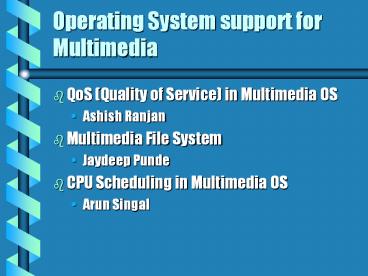Operating System support for Multimedia - PowerPoint PPT Presentation
Title:
Operating System support for Multimedia
Description:
Operating System support for Multimedia QoS (Quality of Service) in Multimedia OS Ashish Ranjan Multimedia File System Jaydeep Punde CPU Scheduling in Multimedia OS – PowerPoint PPT presentation
Number of Views:118
Avg rating:3.0/5.0
Title: Operating System support for Multimedia
1
Operating System support for Multimedia
- QoS (Quality of Service) in Multimedia OS
- Ashish Ranjan
- Multimedia File System
- Jaydeep Punde
- CPU Scheduling in Multimedia OS
- Arun Singal
2
Operating system
- Operating system is responsible for orderly and
controlled allocation of resources among the
various executing programs competing for them. - Main emphasis of commodity OS (unix, NT) is to
reach fairness and efficiency. - No guarantee given to an application for timely
execution.
3
Multimedia characteristics
- Multimedia needs real time support.
- If data is not processed at certain pace and
within a certain deadline the data looses its
meaning. - Adhering to deadlines is desirable but not
absolutely necessary, i.e it is soft real time in
nature.
4
Problems with existing systems
- Does not support soft real time characteristic of
multimedia stream. - When real time algorithms applied, other
application starve. - Need to support all types of application, i.e
both best effort and real time.
5
Problems Cont.....
- No existing algorithm to satisfy both best effort
and real time need. - So, how to schedule/reserve resources for
application?
6
QoS Paradigm
- QoS means to provide reliable and efficient data
delivery service. - To support all types of application, a middleware
necessary to manage resources. - Encompasses both HRT and SRT paradigm.
- Provides probabilistic assurance that resource
requirement will be satisfied a certain fraction
of time.
7
QoS Requirements
- Multimedia QoS requirement as described by the
high level parameters are - Throughput
- Delay
- Jitter
- reliability
8
Resource Management and QoS
- Tasks
- Specification
- It is concerned with capturing application level
quality of service requirements and management
policies - QoS mapping
- This is concerned with converting the high level
specification into actual resource level
parameters (low level parameters)
9
Tasks Contd....
- Admission control
- includes a test whether enough resources are
available to satisfy the request without
interfering with the previously granted request - allocation and scheduling
- This is where actual resources are allocated and
scheduled - Accounting/Policing
- implies tracking down the resources consumed by
the task - Deallocation
10
Task Contd...
QoS Specification
11
Mapping
- Why Mapping is necessary?
- QoS parametres are specified at a high level
- Exact resource requirement are not known to
application
12
QoS Mapping
- Scaling
- As the data passes trough different layers of
protocol, protocol headers are attached to the
frame, which increases its size, and hence
scaling of required application bandwidth is done - Delay Partioning
- The delay is partitioned across each module.
13
Bottlenecks for providing QoS
- QoS should be supported at all layers of
communication - Data packets from the network are processed in
First in first out basis for all connection - Kernel do a lot of hidden processing with high
priority - The layered architecture of the communication
systems may imply considerable data movement in
the protocols - Accounting in OS.
14
Nemesis
- Designed with a view to support QoS paradigm
- Single address space to avoid context swithching
15
QoS in Nemesis
16
Conclusion
- QoS paradigm encompasses both HRT and SRT and
hence is best suited for multimedia system. - QoS should be provided at each layer to achieve
the desired goal.
17
References
- 1 Ralf Steinmetz ,"Analyzing the Multimedia
Operating System", IEEE MultiMedia, 2, 1, pp
68-84 (Spring 1995). - 2 T.Plagemann, V.Goebel, P.Halvorsen, O.
Anshus, "Operating system support for multimedia
systems",Computer communications,23,3,pp
267-289,(2000). - 4 P. Goyal and X. Guo and H. Vin "A
hierarchical CPU scheduler for multimedia
operating systems ", In Proceedings of the
Second Symposium on Operating Systems Design and
Implementation (OSDI). USENIX, October 1996.
18
References
- 5 Schulzrinne, H., "Operating System Issues for
Continuous Media," Multimedia Systems, vol. 4,
pp. 269--280, Oct. 1996.































